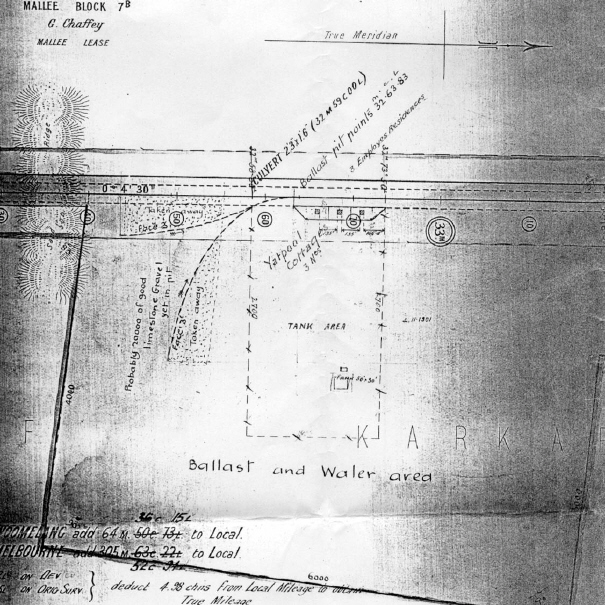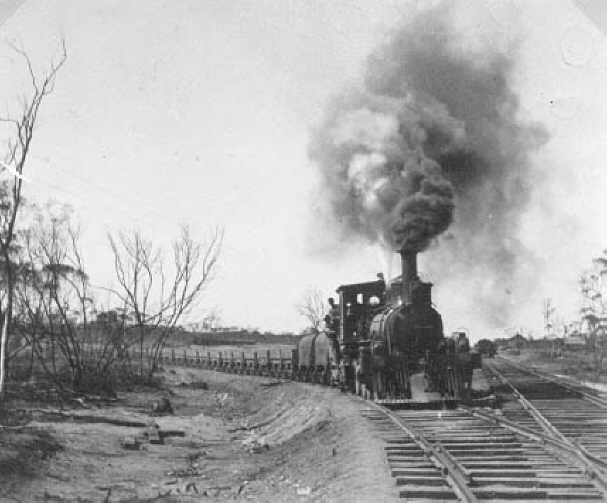
<< Back | Home | Site Map
Origin of name: Aboriginal - name for plain with water holes.
Station opened: 30-9-1903
Station closed: 7-3-1960
Distance from Melbourne (via Castlemaine): 338 miles 22 chains 15 links; 544.404 km
Height above Sea Level: 160 feet
Yatpool was called Karadoc Siding until it was officially named with the opening of the line. Yatpool was the end of the line from 30-9-1903 until the line was finally opened through to Mildura on 27-10-1903. A loop siding and passenger platform was most likely provided at this time with two portable huts transferred from Nowingi.
A large ballast and water area was reserved adjacent to the station grounds on the eastern side of the line. Limestone gravel suitable for railway ballast was obtained from here and a siding was constructed into the reserve at the time of construction of the line. The land was also reserved for a race-course and water tank. Ballast for the Mildura to Merbein line was also obtained from this reserve during 1910. There is a reference in the "Mildura Cultivator" to staff being temporarily stationed at Yatpool during this period.

Yatpool ballast siding showing on engineer's drawings for construction of railway to Mildura. 1904. Source: Railway Construction Branch, Bruce McLean Collection
Yatpool was closed for goods traffic by 28-3-1904. Tenders for three employee's residences were called on 27-8-1904 and were erected on the up side of the line.
On 20-5-1907, instructions were issued to construct a loop siding and on 11-9-1907 staff locks were fitted to the siding. Instructions were also issued to erect "Limit Boards" on 20-11-1907.
By 14-8-1911, Yatpool was operated under no one in charge conditions supervised by Woomelang until 23-12-1912 when supervision was transferred to Hattah.

S300 with three water tanks and a rake of ballast wagons on the Yatpool ballast siding. A portable building on Yatpool station can be seen in the right background as well as a tent. There does not appear to be a loop line constructed at this time, making the year most likely1903. Photo: Wilf Henty, courtesy John Kiely
Passenger and goods platforms were constructed and completed on 26-5-1913. The Commissioners agreed in 1913 to construct a level crossing over the ballast siding. This level crossing would eventually be the future site of the Calder Highway. There were two departmental residences located on the up side of the line.
Yatpool was opened as a temporary staff and telegraph station in February 1915 for the running of special water trains. Up and Down home signals were provided on the main line and an additional Staff Lock was provided on the ballast siding points on 20-7-1915. An additional level crossing was also provided for settlers.
Yatpool was opened as a permanent staff and ticket station on 28-7-1919, and it was most likely at this time that No.2 road was established as a crossing loop with dead-end extensions at each end and a loop siding was provided as No.3 road.
The electric staff system was introduced on 15-7-1924 when the sections Hattah to Yatpool (28.5 miles) and Yatpool to Red Cliffs (4 miles) were more evenly distanced by the closing of Yatpool as a staff station and the establishment of Carwarp as a staff station on the same date.
The home signals were removed on 1-3-1926.
Relaying of the main line with 80 pound rails had reached Yatpool by November 1930.
Yatpool was worked under caretaker conditions from August 1931 being supervised by Red Cliffs. Records available show that Mrs. E. Beeston was appointed in 1933.
Portion of No.2 road between the points of No.3 road were removed by 31-1-1941. The ballast siding was closed and removed before this time. Noted railway historian Mr. J. McLean observed in correspondence to the author that he inspected Yatpool in 1940 and the ballast siding was not there.

Safeworking arrangement diagram for Yatpool following the removal of No.2 road. 31-1-1941. Source: Bruce McLean Collection
From 7-12-1953 the station was operated under no one in charge conditions and Yatpool was closed for all traffic on 7-3-1960.
Tenders were invited in early 1962 for the removal of a departmental residence to Ouyen.
Murray River fish were transported by train from Yatpool. To transfer the fish from the river camp to Yatpool station, a spring cart (later a motorised vehicle) was used. The fish, mainly cod and perch, were kept alive in a fish punt and then killed and gutted for market. They were placed on a bed of boughs in cane baskets. Boughs, fish, boughs, fish...etc. There was no ice. The gills had to be left in the fish to prove that they were alive when prepared for market. Washed Hessian cloths were used to wipe out the gutted fish prior to packing them in the baskets. The fish baskets were of two varieties - a long narrow basket for the Ballarat market and a shorter, fatter basket for the Melbourne market. The train stopped at the Yatpool station to collect the fish.
| << Back | Home | Site Map | Copyright © 2003 Bruce McLean, All Rights Reserved |